alternative therapy
who wants a cuppa? If you cup something in your hands you hold it supportively and intentionally – you take care of it and protect it. The traditional Chinese medical treatment of cupping seems to adhere to these same principles. - Jennifer Mellberg Damien Bell is a man who obviously loves life and personally embraces the philosophies upon which his Chinese medical practice is based. What makes talking with him so interesting are several factors. Firstly, it is sometimes assumed that anyone who practices an alternative therapy would be critical of Western medicine and lifestyles. While Damien has personally made other choices, instead of criticising our exhausting lifestyles, he suggests the world is also filled with indescribable beauty – of which our lives are just one example. Secondly, although there are some similarities, practitioners of Traditional Chinese Medicine understand the human being, and disease, differently to Western doctors. Damien explains, “A disease is like a virtue. It is letting you know that something is unbalanced... my role is to be sure I don’t just take away the discomfort without understanding the whole ‘story’ this person is telling”. Damien is clear that treating physical symptoms creates an effect upon the whole person. For those of us who have grown up with the idea of ‘body’ and ‘soul’ as separate aspects, the idea of treating the ‘whole’ person with a physical technique might seem strange. Yet, Damien explains that while a client may complain of, say, back pain or a digestive complaint – and be delighted with the relief they receive from their treatment – he is never surprised to hear that life in general seems less stressful or that some other concern has eased. And so, as Damien explains client treatment options, we talk about diet and the importance of cultivating a quiet mind. Terms such as ‘meridians’, the ‘five elements’ (wood, fire, earth, metal, water), ‘acupuncture’, ‘yin and yang’ and ‘cupping’, entered our conversation. Cupping is just one of a number of treatments Damien practices. It is an ancient therapy and the story of cupping is a fascinating exploration in itself. Just to whet your appetite: Ge Hong, a famous Taoist alchemist who lived between 281 and 341 A.D., first described a treatment that used cups made from animal horns. Although Damien has observed this – as well as practitioners using bamboo cups – glass cups are the norm here.
Photographer: Anthony Webster
These glass spheres are warmed and then applied to the body so that, as they cool, they adhere firmly and draw the skin and superficial muscle layer up slightly into the cup. The method allows the practitioner to both diagnose problems and treat symptoms. Discolouration of the skin – which can resemble a bruise – guides practitioners in identifying problems and choosing other treatments. Commonly, the cups are placed over the back or abdomen and left in place for between five and 15 minutes. Critical factors are accurate positioning, the degree of suction created and the length of time the cups are left in place. Among many other benefits, cupping is claimed to diminish blood toxins, ease tension, reduce the severity and length of colds and flus, ease muscular pain and is also prescribed for gynecological, skin and digestive conditions (especially in children). Professor Edzard Ernst, from the department of complementary medicine at the University of Exeter, says cupping is relatively safe and, while acknowledging the lack of clinical trials and Western scientific evidence for its effectiveness, notes “There have … been satisfied customers for 3,000 years”. (BBC news online 2004) ■
TOP: The glass cups are warmed and then applied to the body. ABOVE: Damien Bell is a passionate Chinese medicine practitioner.
149
